Costco Business Model Canvas 2024
Costco, the warehouse retail giant known for its bulk offerings and beloved $1.50 hot dog combo, has revolutionized shopping by transforming the act of buying in quantity into an treasure hunt-like experience where members can stumble upon everything from gourmet cheeses to caskets. In this Costco Business Model Canvas, I will identify its customer segments, value proposition, revenue streams, channels, customer relationships, key activities, key resources, key partners, and cost structure.
Interesting fact!
The company has a strict “14% rule” for marking up products. Unlike most retailers, they never mark up products by more than 14% over cost.
Costco Competitors
Walmart | Sam’s Club | Amazon | Target | BJ’s Wholesale Club | Kroger | Aldi | Lidl | Tesco | Carrefour
Customer Segments – Costco Business Model Canvas
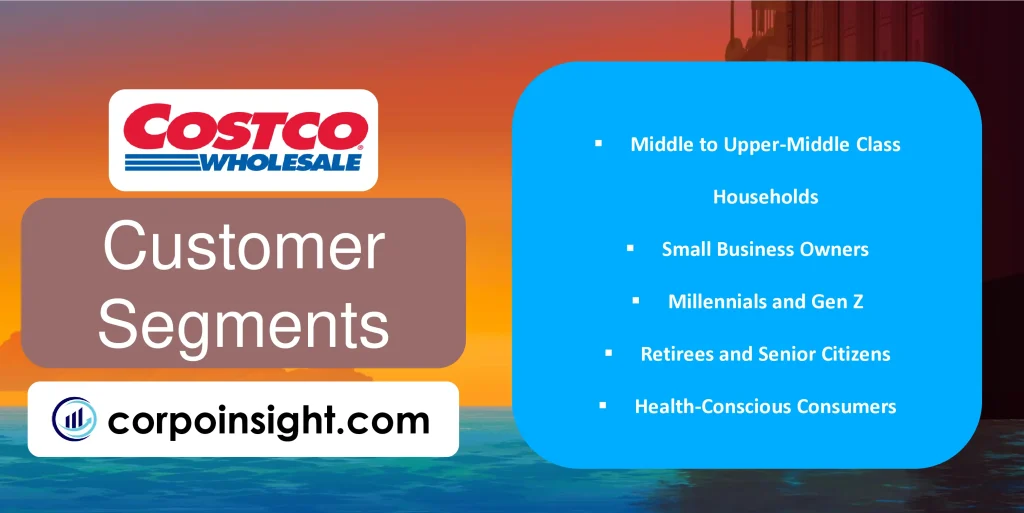
Middle to Upper-Middle Class Households: Costco primarily targets families with annual incomes exceeding $100,000, as these consumers have the means to purchase in bulk and pay the annual membership fee, which ranges from $60 to $120; this demographic often seeks value without compromising quality, aligning perfectly with Costco’s business model.
Small Business Owners: A significant portion of Costco’s customer base comprises entrepreneurs and small business proprietors who leverage the warehouse’s bulk pricing to stock their shops, restaurants, or offices; this segment, which includes both brick-and-mortar and e-commerce businesses, values Costco’s competitive pricing and diverse product range.
Millennials and Gen Z: In recent years, Costco has seen a surge in younger members, particularly those in their late 20s to early 40s, who are drawn to the company’s organic and sustainable product offerings, as well as its ethical business practices; this demographic often shops for multi-generational households and appreciates Costco’s blend of quality and affordability.
Retirees and Senior Citizens: The over-60 demographic represents a growing segment for Costco, attracted by the company’s pharmaceutical services, travel packages, and high-quality, affordable goods; many in this group are on fixed incomes and find value in Costco’s bulk pricing, while also enjoying the treasure hunt experience of browsing the warehouse.
Health-Conscious Consumers: As health and wellness trends continue to dominate consumer preferences, Costco has successfully attracted a segment of health-focused shoppers with its expanding range of organic produce, natural foods, and fitness equipment; this group, which spans various age ranges, appreciates Costco’s commitment to quality and its increasing focus on healthier options.
Value Proposition – Costco Business Model Canvas

Bulk Purchasing at Discounted Prices: Costco’s core value proposition lies in its ability to offer bulk quantities of products at significantly reduced prices, which is achieved through high-volume purchasing and a lean operational model; this approach allows customers to save up to 30% compared to traditional retailers on a wide range of items, from groceries to electronics.
Quality Assurance and Curated Selection: While Costco offers fewer SKUs than traditional retailers, it compensates by meticulously curating high-quality products, including its private label Kirkland Signature, which often outperforms national brands in both quality and price; this commitment to quality, combined with a constantly rotating inventory, creates a ‘treasure hunt’ shopping experience that keeps customers engaged and loyal.
Comprehensive Membership Benefits: Costco’s membership model extends beyond warehouse access, offering a suite of services such as discounted travel packages, auto buying programs, and insurance services; moreover, the company’s generous return policy and warranty extensions provide members with a sense of security and value that transcends mere product purchases.
Ethical Business Practices and Employee Welfare: In an era where corporate responsibility is increasingly important to consumers, Costco stands out for its fair treatment of employees, offering higher-than-average wages and comprehensive benefits; this commitment to ethical practices not only attracts socially conscious consumers but also results in low employee turnover, contributing to a consistent and positive shopping experience.
Innovative Omnichannel Experience: While Costco’s warehouse model remains central to its operations, the company has significantly enhanced its e-commerce capabilities, offering same-day delivery through Instacart and expanding its online product range; this omnichannel approach provides members with the flexibility to shop according to their preferences, whether in-store for the full Costco experience or online for convenience.
Revenue Streams – Costco Business Model Canvas
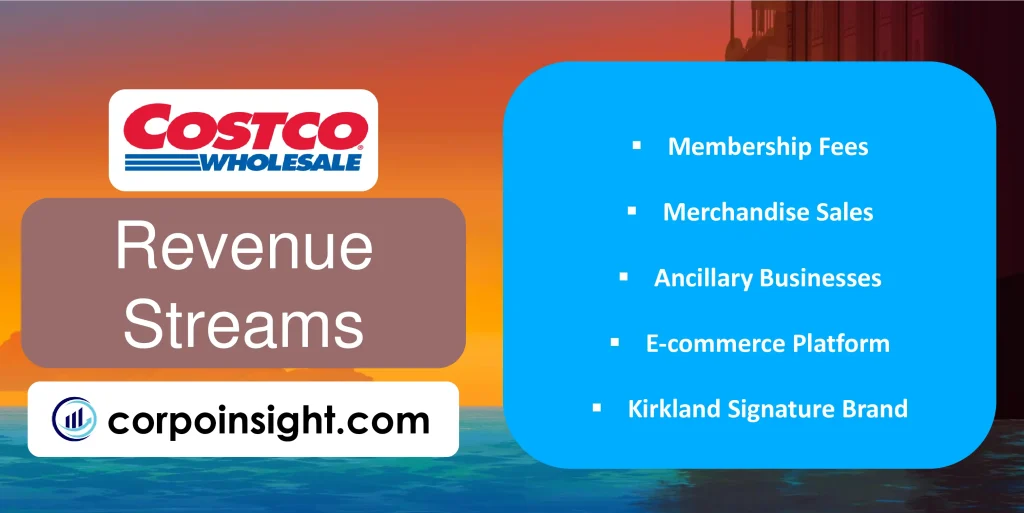
As a business analyst, I’ll analyze Costco’s revenue streams using the most recent data available up to April 2024. Here’s a formal and engaging analysis with complex sentence structures:
Membership Fees: Costco’s primary revenue driver is its membership model, which generated approximately $4.2 billion in fiscal year 2023; this recurring revenue stream, comprising annual fees ranging from $60 for Gold Star to $120 for Executive memberships, provides a stable financial foundation and incentivizes customer loyalty, as members aim to maximize their investment through frequent shopping.
Merchandise Sales: The bulk of Costco’s revenue, accounting for roughly 98% of its total, stems from merchandise sales across various categories including groceries, electronics, and home goods; notably, while the company operates on thin margins—typically not exceeding 15% markup—its high sales volume, estimated at $226.95 billion in fiscal 2023, compensates for the slim profit margins on individual items.
Ancillary Businesses: Costco has diversified its revenue streams through ancillary services such as gas stations, pharmacies, food courts, and optical centers; these additional offerings not only generate substantial income—with Costco being the 4th largest pharmacy in the U.S.—but also drive foot traffic to warehouses, potentially increasing overall sales and membership renewals.
E-commerce Platform: In response to changing consumer habits, Costco has significantly expanded its e-commerce capabilities, which saw a 22% year-over-year growth in 2023; this digital channel, while still a smaller portion of overall sales, represents a rapidly growing revenue stream that complements the traditional warehouse model and caters to the convenience-seeking segment of its membership base.
Kirkland Signature Brand: Costco’s private label, Kirkland Signature, contributes significantly to its revenue, accounting for approximately 25% of total sales; this in-house brand not only offers higher profit margins compared to national brands but also enhances customer loyalty through its reputation for quality and value, thereby indirectly supporting membership retention and overall revenue growth.
Channels – Costco Business Model Canvas

Warehouse Clubs: Costco’s primary channel remains its network of 861 warehouse clubs worldwide, as of 2023, which serve as both retail outlets and distribution centers; these large-format stores, typically ranging from 80,000 to 230,000 square feet, offer a unique shopping experience that combines bulk purchasing with a curated selection of products, driving high sales volumes and customer engagement.
E-commerce Platform: In response to evolving consumer preferences, Costco has significantly enhanced its e-commerce capabilities, which now account for approximately 7% of total sales; this digital channel, accessible via website and mobile app, offers an expanded product range compared to physical warehouses and provides convenient options such as same-day delivery through partnerships with services like Instacart.
Business Centers: Catering specifically to small business owners and institutional buyers, Costco operates 23 Business Centers in the United States; these specialized warehouses, which offer extended hours and a tailored product selection, serve as a crucial channel for capturing B2B sales and strengthening Costco’s position in the commercial market segment.
International Expansion: Costco continues to broaden its global footprint, with a presence in 14 countries as of 2023; this international channel, which includes recent entries into markets like China and New Zealand, not only diversifies Costco’s revenue streams but also provides growth opportunities beyond saturated domestic markets, adapting its model to local preferences while maintaining core value propositions.
Mobile Channels: Recognizing the importance of mobile commerce, Costco has invested in its mobile app, which not only facilitates online shopping but also enhances the in-warehouse experience through features like digital membership cards and warehouse inventory checks; this channel bridges the gap between digital and physical shopping, catering to tech-savvy members and improving overall customer engagement across platforms.
Customer Relationships – Costco Business Model Canvas
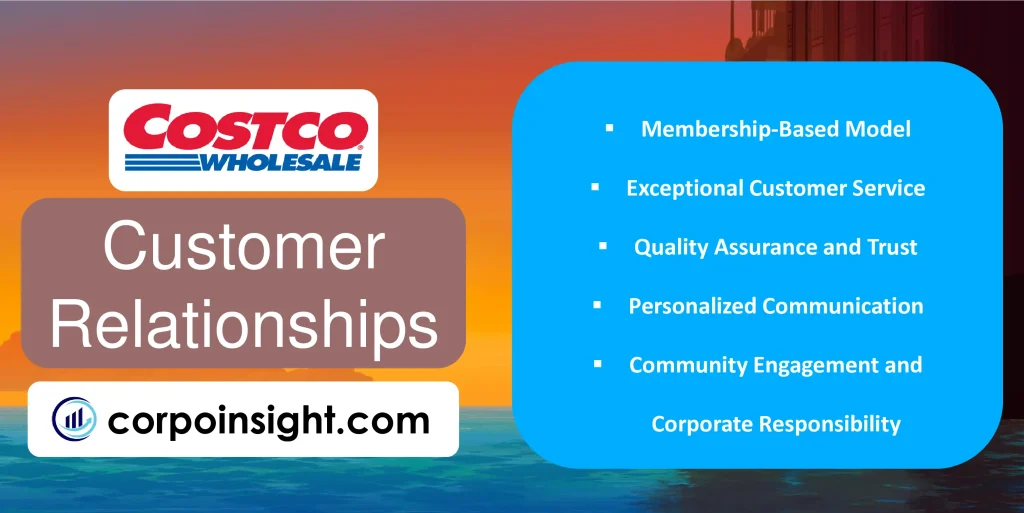
Membership-Based Model: Costco’s cornerstone relationship strategy is its membership program, which boasted 66.9 million paid households globally in 2023; this model fosters a sense of exclusivity and value, with an impressive 92.5% renewal rate in the U.S. and Canada, indicating strong customer loyalty and satisfaction with the Costco experience.
Exceptional Customer Service: Costco’s commitment to customer satisfaction is evident in its generous return policy and attentive in-store service, which contribute to its high American Customer Satisfaction Index score of 81 out of 100 in 2023; this customer-centric approach, coupled with well-trained and fairly compensated employees, creates a positive shopping environment that encourages repeat visits and long-term relationships.
Quality Assurance and Trust: By carefully curating its product selection and offering its high-quality Kirkland Signature brand, which often outperforms national brands in both quality and price, Costco builds trust with its members; this commitment to quality, combined with rigorous product testing and a willingness to discontinue underperforming items, reinforces customer confidence in their purchases and strengthens the overall relationship.
Personalized Communication: Leveraging data from its membership program, Costco tailors its communication through channels like the monthly Costco Connection magazine, which reaches over 14 million households, and targeted email campaigns; this personalized approach, which includes customized offers and product recommendations, enhances the relevance of Costco’s outreach and deepens customer engagement.
Community Engagement and Corporate Responsibility: Costco’s commitment to ethical business practices, including fair wages, sustainable sourcing, and community involvement, resonates with socially conscious consumers; by aligning its values with those of its members, as evidenced by its consistent ranking among America’s Most Responsible Companies, Costco fosters a deeper, values-based relationship that extends beyond mere transactional interactions.
Key Activities – Costco Business Model Canvas
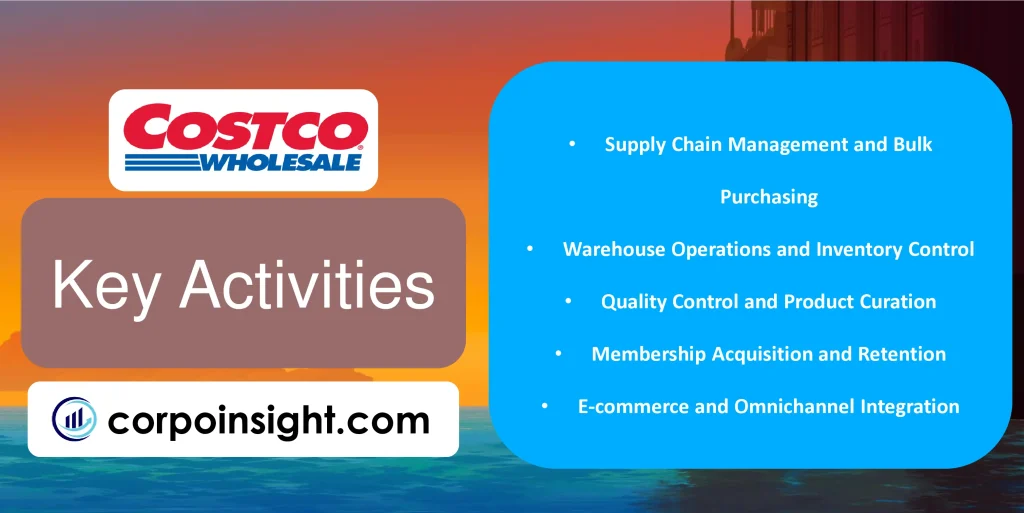
Supply Chain Management and Bulk Purchasing: Costco’s ability to offer competitive prices hinges on its sophisticated supply chain management and bulk purchasing power, which allows it to negotiate favorable terms with suppliers; by limiting its inventory to approximately 3,700 SKUs compared to the 30,000+ found in traditional supermarkets, Costco can focus on high-volume purchasing and rapid inventory turnover, resulting in lower prices for members.
Warehouse Operations and Inventory Control: With 861 warehouses worldwide as of 2023, Costco’s efficient operation of these large-format stores is crucial to its business model; the company employs a “fast-in, fast-out” inventory strategy, which, combined with its minimalist store design and pallet-based merchandising, enables Costco to achieve impressive sales per square foot—$1,567 in fiscal 2023, far exceeding industry averages.
Quality Control and Product Curation: Costco’s meticulous product selection process involves rigorous quality testing and a willingness to discontinue items that don’t meet performance standards; this activity extends to the development and management of its Kirkland Signature private label, which accounted for approximately 25% of sales in 2023 and is often benchmarked against leading national brands for quality and value.
Membership Acquisition and Retention: A core activity for Costco is the continuous effort to attract new members and retain existing ones, as evidenced by its 92.5% renewal rate in the U.S. and Canada in 2023; this involves not only marketing initiatives but also the ongoing enhancement of membership benefits, including the expansion of services like travel bookings, auto program, and insurance offerings.
E-commerce and Omnichannel Integration: In response to changing consumer behaviors, Costco has significantly ramped up its e-commerce capabilities, resulting in a 22% year-over-year growth in online sales in 2023; this key activity involves enhancing the digital shopping experience, improving logistics for home delivery and in-store pickup, and seamlessly integrating online and offline channels to provide a cohesive shopping experience for members.
Key Resources – Costco Business Model Canvas
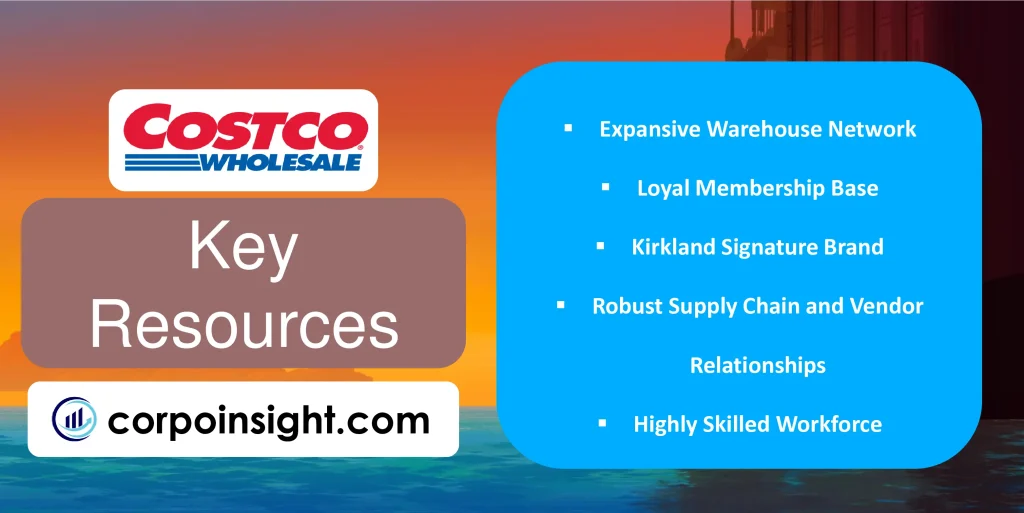
Expansive Warehouse Network: Costco’s 861 warehouses worldwide, as of 2023, serve as both retail outlets and distribution centers, representing a significant physical asset; these strategically located facilities, averaging 146,000 square feet, enable efficient inventory management and create the unique treasure hunt shopping experience that draws millions of members, contributing to Costco’s impressive $226.95 billion in net sales for fiscal 2023.
Loyal Membership Base: With 66.9 million paid household members globally in 2023, Costco’s membership base is not just a revenue stream but a crucial resource that provides stable cash flow and valuable consumer data; this loyal customer base, reflected in the high 92.5% renewal rate in the U.S. and Canada, allows Costco to maintain its low-margin, high-volume business model and informs strategic decisions on product selection and expansion.
Kirkland Signature Brand: Costco’s private label, Kirkland Signature, has evolved into a powerhouse brand that accounted for approximately 25% of total sales in 2023; this in-house brand serves as a key differentiator, allowing Costco to offer high-quality products at competitive prices while maintaining better profit margins, and it has become so successful that it’s now considered a threat to national brands in various categories.
Robust Supply Chain and Vendor Relationships: Costco’s ability to offer low prices stems from its strong relationships with suppliers and its efficient supply chain, which enables bulk purchasing and rapid inventory turnover; these relationships, cultivated over decades, allow Costco to negotiate favorable terms, ensure product quality, and quickly adapt to market changes, as evidenced by its ability to maintain relatively stable prices despite inflationary pressures in recent years.
Highly Skilled Workforce: Costco’s employees, numbering over 304,000 worldwide as of 2023, are a critical resource, known for their high productivity and excellent customer service; the company’s investment in its workforce, offering industry-leading wages and benefits, results in low turnover rates—just 6% for employees who have been with the company for over a year—which contributes to operational efficiency and consistent customer experiences across its global operations.
Key Partners – Costco Business Model Canvas

Suppliers and Manufacturers: Costco’s relationships with a diverse range of suppliers, from global conglomerates to local producers, are crucial to its business model; these partnerships, which include long-standing arrangements with companies like PepsiCo and Procter & Gamble, enable Costco to offer high-quality products at competitive prices while maintaining its limited SKU strategy of approximately 3,700 items per warehouse.
Financial Service Providers: Costco’s partnership with Visa, which became its exclusive credit card network in 2016, has been mutually beneficial, with the Costco Anywhere Visa Card by Citi boasting over 12 million members as of 2023; this collaboration, along with partnerships with other financial institutions, not only provides members with rewards and benefits but also generates significant revenue through cash-back incentives and reduced transaction fees for Costco.
E-commerce and Delivery Partners: To enhance its digital presence and meet evolving consumer demands, Costco has forged strategic partnerships with e-commerce enablers and last-mile delivery services; its collaboration with Instacart, for instance, has expanded same-day delivery options to over 600 warehouses across North America, contributing to Costco’s 22% year-over-year growth in e-commerce sales in 2023.
Travel and Service Providers: Costco Travel, which partners with major airlines, hotel chains, and cruise lines, has become a significant value-add for members, offering exclusive packages and discounts; additionally, partnerships with auto manufacturers, insurance companies, and home service providers expand Costco’s value proposition beyond retail, enhancing member loyalty and driving foot traffic to warehouses.
Technology and Analytics Firms: To stay competitive in the rapidly evolving retail landscape, Costco collaborates with various technology partners to enhance its operations and customer experience; these include software providers for inventory management systems, data analytics firms for consumer insights, and digital payment platforms, all of which contribute to Costco’s ability to maintain operational efficiency and personalize member experiences across its physical and digital channels.
Cost Structure – Costco Business Model Canvas

Cost of Goods Sold (COGS): Representing the largest component of Costco’s cost structure, COGS accounted for approximately 87% of total revenue in fiscal 2023; this high percentage reflects Costco’s low-margin, high-volume business model, where the company leverages its bulk purchasing power and efficient supply chain management to keep prices low for members while still maintaining a slim profit margin.
Labor Costs: As one of the largest private employers in the United States, Costco’s commitment to above-average wages and comprehensive benefits packages significantly impacts its cost structure; despite these higher labor costs, which contribute to selling, general, and administrative expenses (SG&A) of around 10% of revenue, Costco benefits from increased productivity and lower turnover rates, ultimately supporting its customer service-oriented business model.
Operational Expenses: Costco’s warehouse-based retail model, while efficient, incurs substantial operational costs including rent, utilities, and maintenance for its 861 locations worldwide; however, the company’s minimalist approach to store design, combined with its high sales volume per square foot ($1,567 in fiscal 2023), helps to offset these expenses and contributes to its overall cost-effective operations.
Technology and E-commerce Investments: In response to evolving retail trends, Costco has increased investments in its e-commerce platform and digital infrastructure, which, while adding to short-term costs, are crucial for long-term competitiveness; these investments, including enhancements to its website, mobile app, and last-mile delivery capabilities, are aimed at improving the omnichannel shopping experience and driving future growth in online sales, which saw a 22% year-over-year increase in 2023.
Membership Program Administration: While membership fees represent a significant revenue stream for Costco, the administration and marketing of this program incur costs; these expenses, which include member acquisition efforts, loyalty program management, and the production of the Costco Connection magazine (reaching over 14 million households), are offset by the high renewal rates (92.5% in the U.S. and Canada in 2023) and the ancillary benefits of customer data collection and targeted marketing opportunities.
Summary of Costco Business Model Canvas

Conclusion on Costco Business Model Canvas
Costco’s success stems from its member-centric approach, leveraging a high-volume, low-margin strategy supported by efficient operations and strong supplier relationships. The company’s value proposition of quality products at competitive prices, coupled with its membership model, fosters customer loyalty and steady revenue streams. Costco’s adaptability to e-commerce trends and commitment to employee welfare further strengthen its market position, ensuring continued growth and customer satisfaction in a rapidly evolving retail landscape.

Majoring in marketing from Bangladesh University of Professionals, Sadman Abrar is a learner, obsessed with branding and intrigued to learn about different company strategies, and currently working at bKash.






